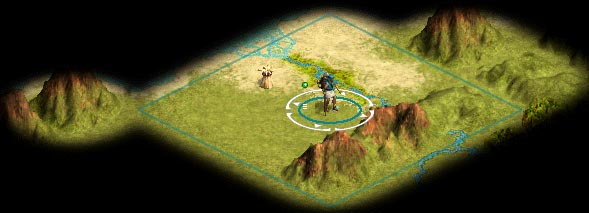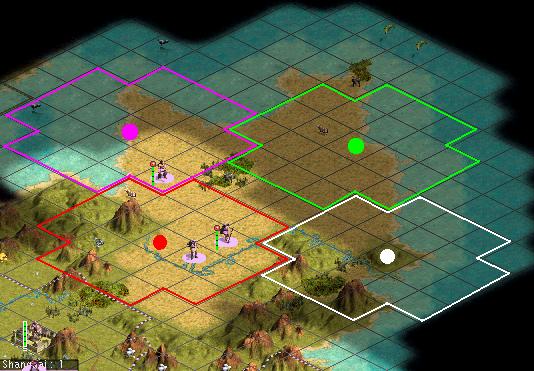 |
Sponsor: Griselda
Opening Date: Monday, April 5
Duration: Four Weeks
Map Generation: Random,
minor edits Difficulty:
Emperor
Civilization: Hittites
World Size: Small
Opponents: Five
Terrain: Continents, 60% water
Climate: Arid, Flat
Barbarians: Raging
Rules: Cultural Link, Respawn disabled
Victory: Only Space Ship is enabled
Version: Conquests 1.15 beta 

Scenario
Concept: According to the Civilopedia, "The end of the Hittite Empire
came around 1100 BC, when mass migrations from Europe and the Caucasus caused
the Empire to dissolve into dozens of small, semi-autonomous city-states."
In this game, we're going to see if we can make better use of a semi-autonomous
collection of city-states. Can you guide the Hittites to a Space victory? Veteran
Epics players will remember a similar scenario- Epic
Fifteen: Soyuz. However, so many game concepts have changed since that
time that I thought it would be interesting to try something similar again. As
the Epics "turn 40", why not take a moment to look back to when we were
just 15? In
this game, each of your cities will function somewhat autonomously. Each city
is very proud and fiercely independent. As a result, the tiles around a city may
only be improved by the native workers trained at that particular city. That is
to say, each city has its own self-trained workers, and these never migrate. The
workers would not want to cheapen themselves by improving the tiles of another
city, and the cities would not lower themselves to using non-hometown labor! Also,
there will be no tile overlap in this game. Each city demands the right to be
in complete control of all of its tiles! The only hope for the Hittites, then,
is that the city-states can be held together by the firm hand of a strong leader.
Thus, you may not switch to a representative government. 
Rules
change: Cities may be founded on marsh tiles. The tile will auto-clear as
the city is built. Variant
Rules about Workers:
* Each city must produce its own workers, and only
those specific workers may improve its tiles.
* Your initial worker "belongs"
to your capital city.
* Each city is allowed to produce only ONE worker unit.
* Each city that constructs a Hospital improvement may train a second worker unit.
* Only workers native to a particular city may improve its tiles (including pollution
cleanup).
* Your workers must remain within your cultural boundaries at all
times.
* Any worker is allowed to improve tiles (within your borders) that
are "neutral": tiles not within usable range of any city. However, only
one such worker at a time per "neutral" tile.
* If escorted by military
units, workers may leave your cultural boundaries ONLY for the purpose of founding
a resource colony -- they are also allowed to build roads up to the colony site.
You must keep track of which city's worker was used on the colony, so that you
can determine which city is allowed to train a new worker unit.
* If a city's
worker is captured, you may train a new one. If the captured worker is liberated
from enemy control AFTER you have trained a replacement, you should immediately
meld one of the two back into the city ("join city").
* You are
not allowed to make use of the workers of any other civilization. If you acquire
them, you must sell them, or merge them into your cities as population, or disband
them.
* You may not automate any of your workers by any method at any time.
Even pollution control must be handled manually, as only the native workers of
a given city are allowed to work on its tiles. The game will not keep this straight,
so you are required to handle it. Variant
Rules about Government:
* You are not allowed to enter Republic or Democracy,
ever. Beyond that, you may choose the government that you feel best serves your
needs. You're not religious, so choose with care! Variant
Rules about Cities:
* You are allowed a maximum of fourteen cities. If
you already have fourteen, you may only acquire another if you abandon one of
your current cities.
* You are never allowed to found a new city that would
have ANY tile overlap between its native 21 tiles and those of ANY other currently-existing
city. (We don't want competition over tiles in disputed or shared regions. A new
city has to plant itself far enough away so as to not infringe on the territory
of existing cities).
* If the AI's settle aggressively, causing overlap or
potential overlap with any of your cities, there's nothing you can do about it,
except that you are urged to do your best to maintain cultural dominance in the
area, if at all possible. However, your city MUST be founded first in that situation.
If the AI's settle first in a spot that would conflict with your planned site,
you must change your plans. You are not allowed to found any of your cities in
any spot that would overlap, even it means a chunk of tiles are inaccessible to
you. (With 40% land, there will be enough land available that you can afford to
waste tiles and still win). Keep in mind that verifying whether your city was
founded before a conflicting AI city would be a simple matter: to check the "date
founded" for each in the city screen. So take care with this one, we may
opt to verify results in some save files.
* If an overlap city founded in
the gaps (by the AI) offers to flip to you, you are allowed to accept or rebuff
it as you see fit. However, any such city is NOT allowed to have its own workers.
It is to be considered a "suburb" of your native Hittite cities.
* Suburbs do not have their own workers. They may "borrow" a maximum
of ONE worker at a time, and only from Hittite cities with which they overlap.
(Can be more than one, which could get very confusing, so... one borrowed worker
at a time. Try not to mix them up).
* Suburbs DO count toward your fourteen
city limit, so if you already have fourteen cities, you are REQUIRED either to
rebuff the rebels or to disband one of your cities by the end of the turn, so
that you remain at fourteen (your choice as to which). Here's
a "dotmap" drawing below. If you start with the green dot location,
then the white and purple locations would be illegal. You could not settle there,
because of the overlap tiles (shown with the red X's). 
On
the other hand, if you had settled the white and purple locations (above) and
then the AI settled the green location, then if the green city flipped to you,
it would qualify as a "suburb" of both the white and purple cities.
The green city could then "borrow" a worker from either white or purple,
but only one at a time. AND you would be responsible for tracking your workers,
so that you don't come back later, see that White has no worker, and train it
a new one, when in fact its worker is busy doing subcontract work for Green Suburb. Below
you see the "optimal" legal configuration of cities. Note that a few
tiles are still wasted. This is the best you could do. You are required to avoid
overlap. If you need help figuring out where to legally put your cities, you can
turn on the grid by pressing Ctrl-G. You can also take screen shots with the grid
active, then paste into an image program and fiddle around with drawing your own
dotmaps if you like. 
That's
not the only way to fit your cities together, but all other legal patterns waste
more tiles. Even if you try to match the perfect pattern, though, the game will
throw a wrench into your gears: a mountain the wrong spot, fresh water access,
AI moves, the shape of the coastline, etc. You'll have to adapt as you play. Variant
Rules about Warfare:
* You are NOT allowed to attack any rival cities
(by any means) if you are listed first in the world in territory (F11). (This
game is supposed to be about the space race, NOT about early conquest and then
milking the already-won game into the modern age to launch).
* Also, no sandbagging
on the cultural improvements just to "control less land" so you have
a loophole that will allow you to attack for longer.
* You may attack rival
cities ONLY until such time as you take the lead in territory. Then you must stop.
(You can remain at war if you like).
* If you have less than fourteen cities,
you may accept an enemy city that offers to flip and create a new suburb with
it, even if you are already number one in the world in territory.
* You are
allowed to raze AI cities, rather than capture them, but remember that you are
no longer allowed to continuing attacking more cities once you are tops in territory.
* You are allowed to pillage enemy resources during any war, and even to run a
military blockade of such resource tiles while at war, but if you are number one
in the world in territory, then you are NOT allowed to pillage at will, as that
constitutes an "attack" against an enemy city. Your military may play
a pivotal role in this game, but will not be able to win the game for you. Variant
Rules about Espionage:
* You are not allowed to conduct Propaganda if
you already have fourteen cities.
* You ARE allowed to conduct Propaganda
if you have less than fourteen cities, even if you are tops in the world in territory. This
is a long list of variant rules, but they all tie together once you "get"
the idea, that this is to be a space race game with restrictions on cities and
workers, and restrictions also on warfare and government that support the main
theme. Each player should copy the rules to their local machines for reference.
I wanted to go with fewer rules than this, but the concept had a lot of loopholes
and I wanted to head them all off in advance. Scoring:
Ranked by fastest finish, with victories ranked above defeats. 
Closing
date: Monday, May 3, 2004. Reports due May 3 or 4.  Download Epic Forty!
Download Epic Forty!
Read
Epic Forty Results 
|  |














